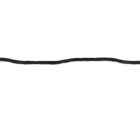 Eurasia occasionally fires long-range, but not stealthy, fast-cruise missiles at a particular target in Eastasia. These missiles fly at 2,000 miles per hour. Eastasia’s radar system, located at the target site, can detect them when they are within 1,000 miles of the target, giving 30 minutes warning.
Eurasia occasionally fires long-range, but not stealthy, fast-cruise missiles at a particular target in Eastasia. These missiles fly at 2,000 miles per hour. Eastasia’s radar system, located at the target site, can detect them when they are within 1,000 miles of the target, giving 30 minutes warning.
Eurasian engineers have developed a somewhat stealthy cruise missile, of similar physical shape and size as the nonstealth missile. This new missile diffusely reflects the radar energy that hits it at a rate only 10 percent as great as the rate for the nonstealth missiles, but only flies at 1,000 miles per hour. How much radar warning time will Eastasia have when they are attacked by this new missile?
Eurasian engineers also have a very advanced research project underway to develop a super stealthy cruise missile, again with a shape and size not very different from the previous missiles, that will only give Eastasia a five-minute radar warning. This super stealthy missile will only be able to fly at 500 miles per hour. For this super stealthy missile, what will the diffuse reflection rate of radar energy that hits it, relative to the rate of the nonstealth missile, need to be?
Know the answer? Send your solution to ar@casact.org.
Hanging Rope

Two ends of a rope are fixed to the tops of two poles standing straight above a flat ground surface. The poles are unequal in height, with one pole being twice as tall as the other. If the length of the rope is such that it is taut and it forms a straight line between the tops of the poles, then its length is equal to the sum of the heights of the two poles. What is approximately the maximum possible percentage increase in the rope’s length, relative to its length when taut, so that its lowest hanging point will still be no lower than the top of the shorter pole? What is approximately the minimum percentage increase in the rope’s length, relative to its length when taut, so that its lowest hanging point just barely touches the ground?
Several people submitted very interesting solutions that we have posted online.
Glenn Meyers pointed out that the equation for a (flexible) hanging rope, the “catenary,” is a classic one originally solved by Christiaan Huygens, Gottfried Leibniz and Johann Bernoulli in 1691.
Below is the solution narrative that Bob Conger submitted, along with a very nice diagram submitted by solver Hannah Park:

“I made the simplifying assumption that the earth is flat, or at least the scale of the poles and rope is small enough that we can ignore curvature of the earth and the fact that gravity would not be acting quite parallel to both poles.
We can choose our own units of measurement, so let’s say the short pole is a length of 1, and the long pole is a length of 2. Then the taut rope has a length of 3, and some good old-fashioned geometry leads us to the distance between the two poles as SQRT ( 32 – 12) = √8.
“Just to set some broad order-of-magnitude, the rope will be longer than 3 in the two scenarios. In the first scenario, the rope should be just a little bit longer than 3, and quite a bit shorter than 1 + √8 = 3.83 (approx.), which would be straight down the top half of the tall pole + straight across to the other pole. In the second case, I expect that the rope will be a bit longer than 4.1 (which would be a rope straight down to a point on the ground one-third of the way between the poles, and straight back up to the top of the tall pole), but quite a bit shorter than 5.83 (straight down each pole to the ground, and straight across the ground between the poles).
“Poking around the literature, I find that a hanging rope has a shape labeled as a ‘catenary,’ which is mathematically described with the hyperbolic sine (Sinh) and hyperbolic cosine (Cosh) functions. Draw the x-axis tangent to the lowest point on the hanging rope and draw a z-axis through the point to tangency, perpendicular to the x-axis. Define x1 as the distance from the xz origin to the left-hand pole, and x2 as the distance from the xz origin to the other pole. In our specific problem, x1 + x2 = √8. Then for any x value between the origin and one of the poles (we use the convention of x being a positive number in both directions from the origin), the height of the rope at that point is
z = a Cosh(x/a) – a
and the length of the rope, y, from the origin to that point is
y = a Sinh(x/a).
“Rearranging the first equation
x = a Cosh-1 ( ( z + a ) / a ).
“In all cases, a is a constant scaling factor that is related to the tension on the cable and the weight of the cable per unit length.
”I solved problem 2 first, since it seems more like the conventional hanging rope problem. In problem 2, we know that z1 =1 and z2 = 2, and we know that x1 + x2 = √8. Thus, the equation for x2 can be expressed as
x2 = √8 – x1 = a Cosh-1 ( ( 2 + a ) / a )
and the equation for x1 is
x1 = a Cosh-1 ( ( 1 + a ) / a )
and we have two equations and two unknowns. I found it easiest to solve iteratively in Excel, rather than algebraically, and arrived at (approximately)
a = 0.865007
x1 = 1.21335
x2 = 1.61508
y1 = 1.65227
y2 = 2.73131
length of rope = y1 + y2 = 4.38358, which is approximately 46.1 percent longer than the taut rope.
“Happily, this is a bit longer than 4.1, as expected.
“For problem 1, we conceptually adjust z1 = 0 and z2 = 1. I wasn’t quite sure what would happen to the math with z1 = 0, so I tried reducing z1 and z2 from their original values somewhat gradually, but always keeping z2 = z1 + 1. As z1 approached zero (but remained positive), a approached 4.15, x1 and y1 approached zero, and the length of the rope approached 3.05.
“So I took the plunge with z1 =0 and x1 = 0, and found
a = 4.15674
y2 = 3.05180, which is approximately 1.73 percent longer than the taut rope.
“In this scenario the rope is tangent to top of the short pole. Any longer, and the rope would droop (slightly) below the top of the short pole.”
A solution was also submitted by Clive Keatinge.











